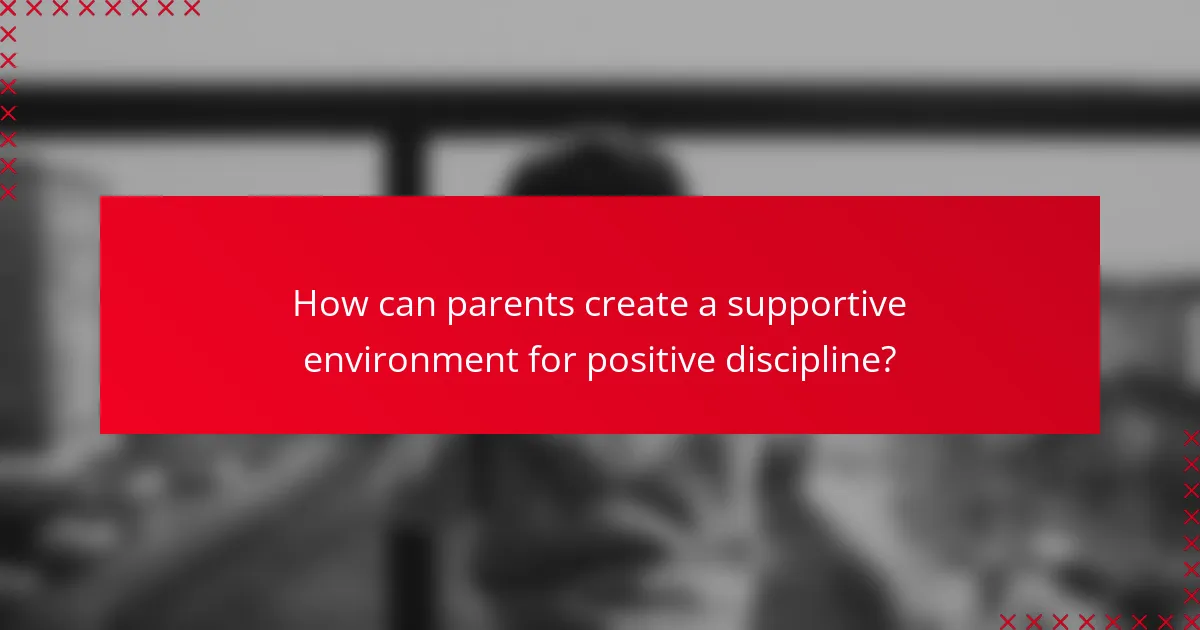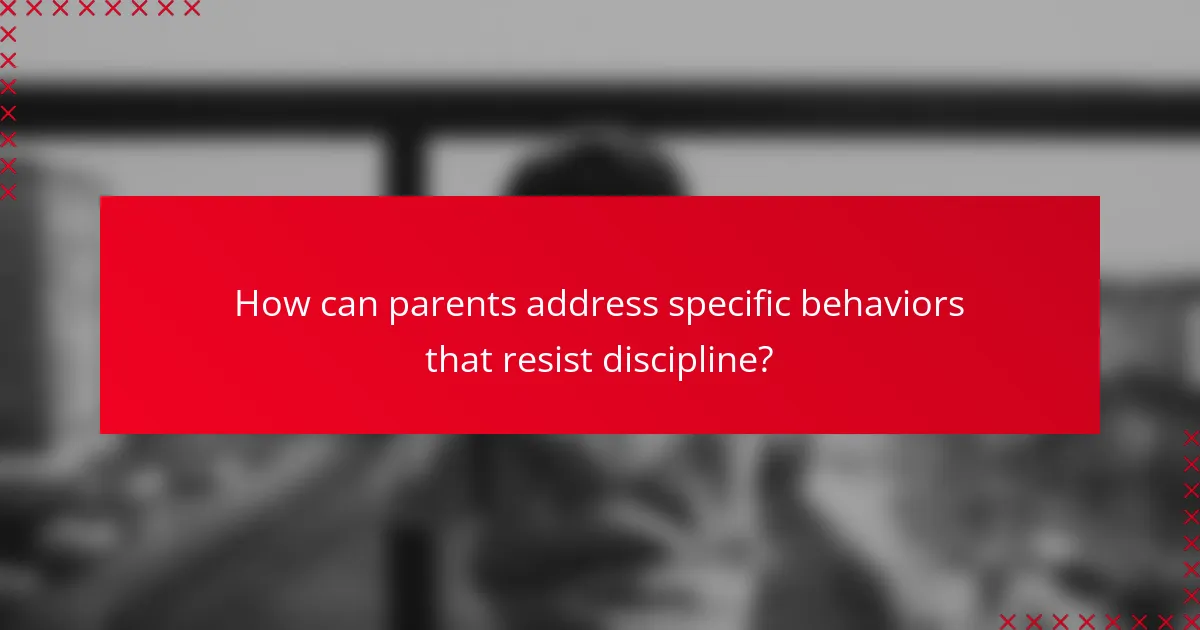Handling resistance to positive discipline requires a thoughtful approach that emphasizes clear communication and emotional intelligence. By setting clear expectations and fostering a supportive environment, parents can help children understand the purpose of discipline and encourage their cooperation. This nurturing atmosphere not only promotes respectful interactions but also aids in developing the emotional awareness necessary for better behavior and decision-making.

What are effective strategies to manage resistance to positive discipline?
To effectively manage resistance to positive discipline, focus on clear communication, setting expectations, and reinforcing positive behaviors. These strategies foster a supportive environment where children understand the purpose of discipline and feel involved in the process.
Consistent communication
Consistent communication is vital in addressing resistance to positive discipline. Regularly discussing rules and expectations helps children understand the rationale behind them. Use simple language and encourage questions to ensure clarity.
Establish a routine for these discussions, such as weekly family meetings, where everyone can express their thoughts and feelings. This approach builds trust and reinforces the importance of open dialogue.
Setting clear expectations
Setting clear expectations helps children know what is required of them and reduces resistance. Clearly outline the rules and the consequences for not following them, ensuring they are age-appropriate and understandable.
Consider using visual aids, like charts or checklists, to illustrate expectations. This can be particularly effective for younger children who may benefit from visual reminders of their responsibilities.
Using positive reinforcement
Using positive reinforcement encourages desired behaviors and reduces resistance. Acknowledge and reward good behavior with praise, small rewards, or privileges. This approach motivates children to comply with expectations.
Be specific in your praise, such as saying, “I appreciate how you shared your toys today.” This reinforces the behavior you want to see more of and helps children connect their actions with positive outcomes.
Modeling desired behaviors
Modeling desired behaviors is crucial for teaching children how to respond to discipline positively. Children learn by observing adults, so demonstrate the behaviors you want them to adopt, such as patience, respect, and empathy.
Engage in role-playing scenarios to practice these behaviors together. This interactive approach can help children understand how to handle situations they may encounter in real life.
Involving children in decision-making
Involving children in decision-making fosters a sense of ownership and reduces resistance to discipline. Allow them to contribute to setting rules or consequences, which can lead to greater buy-in and adherence.
For example, ask for their input on family rules or how to handle specific situations. This collaborative approach not only empowers children but also teaches them accountability and the importance of considering others’ perspectives.

How can parents create a supportive environment for positive discipline?
Parents can create a supportive environment for positive discipline by fostering a nurturing atmosphere that encourages cooperation and understanding. This involves establishing clear expectations, providing emotional support, and promoting respectful interactions.
Establishing routines
Establishing routines helps children understand what is expected of them and provides a sense of security. Consistent daily schedules for activities like meals, homework, and bedtime can reduce resistance and anxiety.
To create effective routines, involve your children in the planning process. This can increase their buy-in and willingness to follow the established guidelines. Aim for a balance between structure and flexibility to accommodate unexpected changes.
Creating a safe space for expression
A safe space for expression allows children to share their feelings and thoughts without fear of judgment. Encourage open communication by actively listening and validating their emotions, which can help them feel understood and respected.
Designate a specific area at home, such as a cozy corner with cushions, where children can retreat to express themselves. This physical space can serve as a reminder that their feelings are important and worthy of attention.
Encouraging open dialogue
Encouraging open dialogue is crucial for fostering a supportive environment. Regularly engage in conversations with your children about their experiences, feelings, and any challenges they face, ensuring they feel comfortable sharing their thoughts.
Use open-ended questions to stimulate discussion and show genuine interest in their perspectives. Avoid interrupting or dismissing their concerns, as this can discourage future communication. Aim for a collaborative approach to problem-solving, reinforcing that their input is valued.

What role does emotional intelligence play in positive discipline?
Emotional intelligence is crucial in positive discipline as it helps children understand and manage their emotions, leading to better behavior and decision-making. By fostering emotional awareness, parents can guide their children through challenges while maintaining a supportive environment.
Understanding children’s emotions
Recognizing and validating children’s emotions is the first step in positive discipline. When children feel understood, they are more likely to respond positively to guidance. Parents can encourage this by actively listening and acknowledging their child’s feelings, using phrases like “I see you’re upset” or “It’s okay to feel frustrated.”
Additionally, teaching children to label their emotions can empower them to express themselves more clearly. Simple tools like emotion charts can help younger children identify what they are feeling, which can reduce outbursts and improve communication.
Teaching empathy
Empathy is a vital component of emotional intelligence that can be cultivated through positive discipline. Parents can model empathetic behavior by expressing understanding towards others’ feelings, demonstrating how to consider different perspectives. This can be reinforced through storytelling or role-playing scenarios.
Encouraging children to think about how their actions affect others can also enhance their empathetic skills. Asking questions like “How would you feel if someone did that to you?” can prompt reflection and foster a deeper understanding of social interactions.
Responding to feelings effectively
Effective responses to children’s feelings can significantly influence their emotional development. When a child expresses frustration or anger, it’s essential to respond calmly and constructively. Avoid reacting with anger or dismissal, as this can escalate the situation.
Instead, guide children through their emotions by offering solutions or coping strategies. For example, if a child is upset about a toy being taken away, suggest taking deep breaths together or finding a different activity. This approach not only addresses the immediate issue but also teaches valuable emotional regulation skills.

How can parents address specific behaviors that resist discipline?
Parents can effectively address resistance to positive discipline by understanding the underlying causes of specific behaviors and implementing strategies tailored to those triggers. This approach fosters cooperation and encourages children to engage positively with discipline methods.
Identifying triggers
Identifying triggers is crucial for understanding why a child may resist discipline. Common triggers include changes in routine, stress from school, or conflicts with peers. Parents should observe their child’s behavior closely to pinpoint these factors.
Keeping a journal of incidents can help track patterns and identify specific situations that lead to resistance. For example, if a child acts out during homework time, it may indicate frustration with the material rather than a refusal to follow rules.
Implementing tailored interventions
Once triggers are identified, parents can implement tailored interventions that address the root causes of resistance. For instance, if a child resists bedtime due to anxiety, establishing a calming pre-sleep routine can help ease their fears.
Using positive reinforcement is another effective strategy. A reward system for following rules can motivate children to engage with discipline more willingly. Simple rewards like extra playtime or a small treat can encourage compliance.
Collaborating with educators
Collaboration with educators is essential for addressing resistance to discipline in a consistent manner. Parents should communicate with teachers to understand how the child behaves in school and share insights about home dynamics. This partnership can provide a comprehensive view of the child’s behavior.
Regular meetings with teachers can help align strategies between home and school. For example, if a child struggles with attention in class, parents and teachers can work together to create a supportive environment that reinforces positive behavior both at home and in school.

What are common misconceptions about positive discipline?
Common misconceptions about positive discipline often stem from misunderstandings of its principles and practices. Many believe it equates to a lack of rules or consequences, which can lead to confusion in its application.
Positive discipline is permissive
One of the main misconceptions is that positive discipline is synonymous with permissiveness. In reality, positive discipline emphasizes guidance and support rather than allowing children to act without boundaries. It fosters an environment where children learn to make choices within a structured framework.
For example, instead of simply saying “do whatever you want,” a parent might say, “you can choose to play outside or read a book, but you need to finish your homework first.” This approach maintains authority while respecting the child’s autonomy.
It lacks structure
Another common belief is that positive discipline lacks structure. On the contrary, it incorporates clear expectations and consistent routines. Children thrive when they understand the rules and the reasons behind them, which helps them feel secure and supported.
Establishing a daily routine, such as set times for homework, meals, and bedtime, provides the structure children need. This predictability helps them navigate their responsibilities while allowing for flexibility in their choices.
It doesn’t involve consequences
Many people think that positive discipline means there are no consequences for misbehavior. However, it does involve appropriate and constructive consequences that are intended to teach rather than punish. The focus is on helping children understand the impact of their actions and encouraging better choices in the future.
For instance, if a child refuses to do their chores, a fitting consequence might be losing privileges, such as screen time, until the chores are completed. This approach reinforces accountability while still promoting a positive learning experience.
